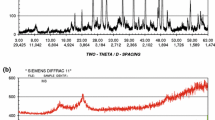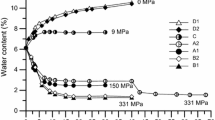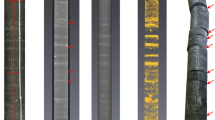Abstract
Nineteen drill core samples of lower Dogger opalinum shale from wells drilled in connection with a tunnel project near Brugg, northern Switzerland, were investigated. The shale is a well known swelling rock that has caused problems in underground construction work. Swelling pressures determined under constant volume conditions to obtain maximum values were 0.7 to 2.2 N/mm2. The samples contained 37–59% clay-size material and about 35% quartz, 7–18% carbonate minerals, and about 5% feldspar, pyrite, and organic matter. In addition to kaolinite, illite, and chlorite, the clay-size fraction also contained mixed-layer illite/smectite with about 30% swelling layers.The specific surface area of the clay fraction was 135 m2/g. The specific surface charge of the clay (6.7 × 104 esu/cm2), the ion concentration in the pore fluid of the specimen after the swelling test (10−2 mmole/cm3), the valence of the ions in the double layer of the clay particles (+1), and the half distance between the clay plates in the specimen (8–15 Å) allowed the calculation of the swelling pressure for each sample according to the Gouy double layer theory.
The mean value of the calculated swelling pressures was found to be of the same order of magnitude as the measured values, indicating that the technique can be used where cylindrical or rectangular specimens are not available for direct measurement.
Similar content being viewed by others
References
Bolt, G. H. (1955) Analysis of the validity of the Gouy-Chapman theory of the electric double layer: J. Colloid Sci. 10, 206–219.
Bolt, G. H. (1956) Physico-chemical analysis of the compressibility of pure clays: Geotechnique 6, 86–93.
Brindley, G. W. (1966) Ethylene glycol and glycerol complexes of smectites and vermiculites: Clay Miner. 6, 237–259.
Brown, G., ed. (1961) The X-ray Identification and Crystal Structures of Clay Minerals: Mineralogical Society, London, 393–445.
Chapman, D. L. (1913) A contribution to the theory of electrocapillarity: Phil. Mag. 25, 475–481.
Einstein, H. H. (1979) Tunneling in swelling rock: Underground Space 4, 51–61.
Füchtbauer, H. (1959) Zur Nomenklatur der Sedimentgesteine: Erdöl Kohle 8, 605–613.
Gouy, G. (1910) Sur la constitution de la charge électrique à la surface d’un electrolyte: J. Physique 9, 457–468.
Gouy, G. (1917) Sur la fonction électrocapillaire: A nn. Phys. (Paris), Série 9 7, 129–184.
Grob, H. (1976) Swelling and heave in Swiss tunnels: Bull. Int. Ass. Engng. Geol. 13, 55–60.
International Society for Rock Mechanics (1979) Commission on Standardization of Laboratory and Field Tests: Suggested methods for determining swelling and slake-dura-bility index properties: Int. J. Rock Mech. Min. Sci. 16, 141–156.
Jahnke, E. and Emde, F. (1933) Tables of Functions: B. G. Teubner, Leipzig and Berlin, 124–144.
Langmuir, I. (1938) The role of attractive and repulsive forces in the formation of tactoids, thixotropic gels, protein crystals, and coacervates: J. Chem. Phys. 6, 873–896.
Mackenzie, R.C. (1951) A micromethod for determination of cation-exchange capacity of clay: J. Colloid Sci. 6, 219–222.
Madsen, F. T. (1977) Surface area measurements of clay minerals by glycerol sorption on a thermobalance: Ther-mochimica Acta 21, 89–93.
Mehra, O. P. and Jackson, M. L. (1960) Iron oxide removal from soils and clays by a dithionite-citrate-system buffered with sodium bicarbonate: in Clays and Clay Minerals, Proc. 7th Natl. Conf., Washington, D.C., 1958, Ada Swineford, ed., Pergamon Press, New York, 317–327.
Müller-Vonmoos, M. (1971) Zur Korngrössenfraktioni-erung tonreicher Sedimente: Beitr. Geol. Schweiz 54, 245–257.
Piper, C. S. (1944) Soil and Plant Analysis: Interscience Publishers, New York, 128–136.
van Olphen, H. (1977) An Introduction to Clay Colloid Chemistry: Interscience Publishers, New York, 260–293.
Verwey, E. J. W. and Overbeek, J. Th. G. (1948) Theory of the Stability of Lyophobic Colloids: Elsevier, Amsterdam, 22–76.
Author information
Authors and Affiliations
Rights and permissions
About this article
Cite this article
Madsen, F.T., Müller-Vonmoos, M. Swelling Pressure Calculated from Mineralogical Properties of a Jurassic Opalinum Shale, Switzerland. Clays Clay Miner. 33, 501–509 (1985). https://doi.org/10.1346/CCMN.1985.0330604
Received:
Accepted:
Published:
Issue Date:
DOI: https://doi.org/10.1346/CCMN.1985.0330604




